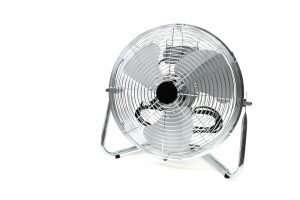When temperatures in a room exceed a certain degree, what do you to lower them? You turn on a fan. Fans cool you off, right? But the fact is they don’t cool everything. In fact, they make your room slightly hotter but make you feel cool.
How Is This Possible?
If you put a fan in an enclosed box and have two temperature sensors, one inside the box and another one outside, and run the fan on “high” setting. You will clearly notice the temperature inside the box rising while the temperature outside remaining constant. If you were to raise the fun speed, you will notice the temperature will rise even more because of the electric current running through it. The more the current, the more the wire gets hot. This is an obvious fact about electric currents. So, with a fan running in an enclosed box, you will notice the temperatures going up.

In the same way, the fan, being an electric device with a coil of wire that has electric current running through it, will make your room temperature go slightly higher but you will not notice because there will be air circulation that will be cooling your body.
But Then You May Ask, Why Do We Use Fans to Cool Our Bodies?
The fan would not cool off an enclosed room. However, it would cool off a human in an enclosed room. Why is this so? It is because a fan does its job in a cople of key ways:
- One is through a key ingredient- liquid water. Evaporation cools off the liquid water. For humans, the liquid water is called sweat. When air moves quickly over sweat, evaporation rate increases. More evaporation results in cooling of a human.
- Another is by exchanging the warm air immediately around your body with cooler air. Basically, as long as the air around you is cooler than your body, the fans air circulation will facilitate a cooling effect by accelerating this natural heat exchange.
Now you know, a fan can warm a room but cools off a human.
However, the reverse can also happen- warm a human and cool the room. It is all about the right setting. Fans follow a specific direction and speed- that’s counter-clockwise direction. When the weather is cold, you don’t want a cool breeze blowing on you. Most fans today have a reverse setting that allows it to run in the clockwise or opposite direction. So, air will be circulating air without creating a cool breeze. However, there is more to it than circulating air. Because warm air still rises, a running fan in clockwise grabs the warm air hanging air and forces it down. The air will go down to the floor and is picked up again by the fan. This will balance the temperature in the room thereby making you feel warmer.
To help you use your fan efficiently in both cold and warm weather, here are two tips to help you;
 Speed zones – in terms of speed, make the fan run faster in summer and slower in winter. In warm days, you want the air to move faster. Therefore, use high-speed setting to create the chill factor. In chiller months, no one wants to feel the wind-chill. Therefore, you need to switch to medium or low settings. The idea in cooler months is to allow heated air to circulate in your room. Ensure your fan is placed at the right height- 10-12 inches below the ceiling or from where you are sitting.
Speed zones – in terms of speed, make the fan run faster in summer and slower in winter. In warm days, you want the air to move faster. Therefore, use high-speed setting to create the chill factor. In chiller months, no one wants to feel the wind-chill. Therefore, you need to switch to medium or low settings. The idea in cooler months is to allow heated air to circulate in your room. Ensure your fan is placed at the right height- 10-12 inches below the ceiling or from where you are sitting.- Blade Direction – when running your fan in the warmer months, make sure the fan’s blades are rotating in counter-clockwise direction. This rotation drives air downwards thereby creating a wind chill effect in the interior environment.
In cooler months, ensure that you switch your fan back to the clockwise rotation so as to pull warm air from the ceiling and push it downwards to the flow. Each model of fan has a different operation method and thus it is important to refer to the user manual on how to switch the blades rotation.
Wrap Up
Little things like the right settings on your fan can make a huge impact. Fans aren’t for summers alone; you can change the direction of your fan’s bald to keep your room warmer.
But if we go back to the topic, we were discussing “Does a fan make a room hotter?”- The correct answer would be Yes it does, but it cools off humans in that room. Contradicting, right? But that’s the fact of the matter.



